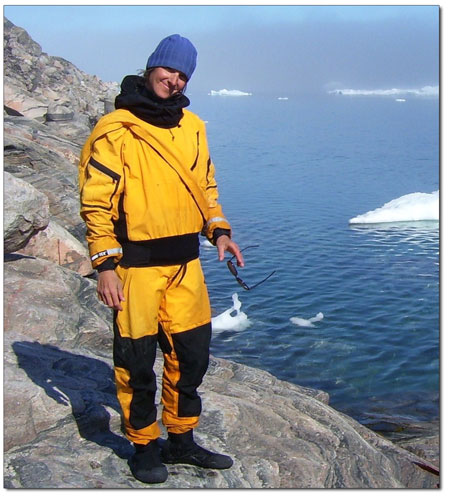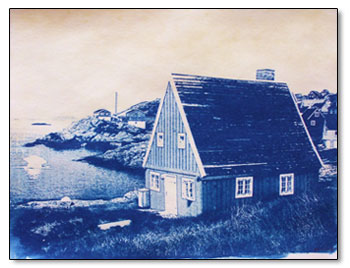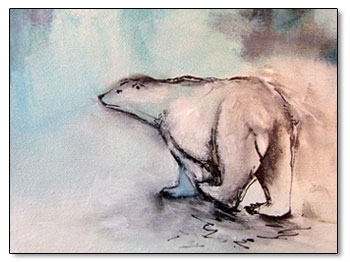 |
|
Rebecca Barfoot stands on the coast of the Arctic Ocean in this self-portrait, taken while kayaking near Tugtulikovsak (aka Little Reindeer Valley), in northwest Greenland. Barfoot spent a two-month artist’s residency there last summer documenting environmental and social ramifications of climate change./Photo by Rebecca Barfoot |
Poised on the precipice
Rebecca Barfoot takes her art to the literal edge
by Stew Mosberg
Durango artist Rebecca Barfoot is a modest but complex individual with immense talent. Her artwork is soulful; purposely void of detail and indicative of the careful introspection of its creator. Not falling into one specific category, she excels in multiple mediums, from ceramics, print-making and painting to photography, film-making and writing. Often, she combines them to communicate her message. For a while now, that message has been about the changing environment and our endangered landscape.
Durango artist Rebecca Barfoot is a modest but complex individual with immense talent. Her artwork is soulful; purposely void of detail and indicative of the careful introspection of its creator. Not falling into one specific category, she excels in multiple mediums, from ceramics, print-making and painting to photography, film-making and writing. Often, she combines them to communicate her message. For a while now, that message has been about the changing environment and our endangered landscape.
“Previously my art referenced the inner landscape,” said Barfoot. “(Now) I understand that my work needs to serve the planet as it hangs in delicate balance. We have so much to lose.”
|
|
Last summer, she took that passion to the northernmost reaches of the globe for a unique artist’s residency in Greenland. The intent of her voyage was to study Arctic environmental and social conditions related to climate change. While there, she laid the groundwork for her forthcoming traveling art exhibit, “Last Places.”
The first leg of her journey was to the Upernavik Museum in the Arctic Circle, which had invited her to participate in the two-month residency. From there, she ventured to the Ilullisat Icefjord UNESCO World Heritage Site and the Climate Research Center in Nuuk.
An ardent supporter for preserving the world’s wild places, Barfoot is genuinely apprehensive about how environmental changes will affect survival and the quality of life for all species. The reports of rising sea levels and evidence of the human impact on climate change, she suggests, is overwhelming for most. “Through art, I seek to find the human scale of this story,” she said.
As one might suspect, living in a tiny, remote cabin on the edge of the planet in starkly cold, eternally sunlit surroundings can be life altering. “It rocked my world!” Barfoot said.
During her time there, Barfoot became familiar with a teaching from Greenland’s Inuit-Kalaallit people that she hopes to incorporate into her work. “It summons us to bridge the distance from our minds to our hearts through gentleness and compassion,” she said. “I hope that in time my Arctic work will come to embody this ideal, as an instrument of cultural transformation and global healing.”
No stranger to artist-in-residence programs, Barfoot has spent long stretches of time in Scandinavia as well as locations here in the United States. She was the first artist-in-residence at the Discovery Museum, where on March 29, she will present “Arctic Art Expedition,” photos and film footage of her own voyage of discovery.
“It will be one part travelogue,4 one part artist’s experience, one part climate discourse,” she said, “a dialogue about art and environment and the possible role creativity and imagination can play in the framing of the larger questions we face collectively at this moment on the planet.”
 |
| A cyanotype print of the Upernavik artist’s residence. |
In January, Barfoot was a presenter at “Regenerate,” a conference focused on the role of art in sustainable culture, sponsored by The Armand Hammer United World College of the American West. Also that month, she began teaching ceramics, sculpture and mixed media at the New Mexico School for the Arts in Santa Fe. Barfoot will briefly return to Durango for her program at the Discovery Museum and a reception for her solo show at Diane West Jewelry & Art Gallery on March 30. Once her classes are done in May, Barfoot plans to return to her home in Durango. “I miss Durango more than you can imagine,” she said.
West said she was drawn to Barfoot’s “Last Places” series because of its environmental undertones and implication that “humans are taking up too much space.”
“It’s a cause that is close to my heart, and I am drawn to any setting where art can foster awareness,” she said. The exhibit will include a series of paintings, cyanotype prints and an installation of objects in porcelain. Like the ephemeral nature of the environment, the show will only be on view for two weeks.
Barfoot’s work is known around the world and was recently featured in the third edition of Ceramics and Print and will be seen in Alternative Photographic Processes/Popular Historical and Contemporary Techniques, due out in June. She is currently represented at the Mariposa Gallery in Albuquerque and Plinth Gallery in Denver.
In the year ahead, the former Durango resident plans to continue working on her “Last Places” project in the Yukon Territory and Arctic Finland. Her soul-searching introspection appears as though it will continue for a very long time, to which she comments, “I feel as if I have pockets full of answers, and instead I have fistfuls of questions. I’m incredibly moved and a little beyond words, which is why there’s art; hanging boats, flying glaciers and sapphire seas, along with more sobering imagery and the difficult work of expressing so much with so little.”
For more, go to www.rebeccabarfoot.com
 |
| “Warming Arctic/Poster Girl” mixed media on canvas by Rebecca Barfoot. |
